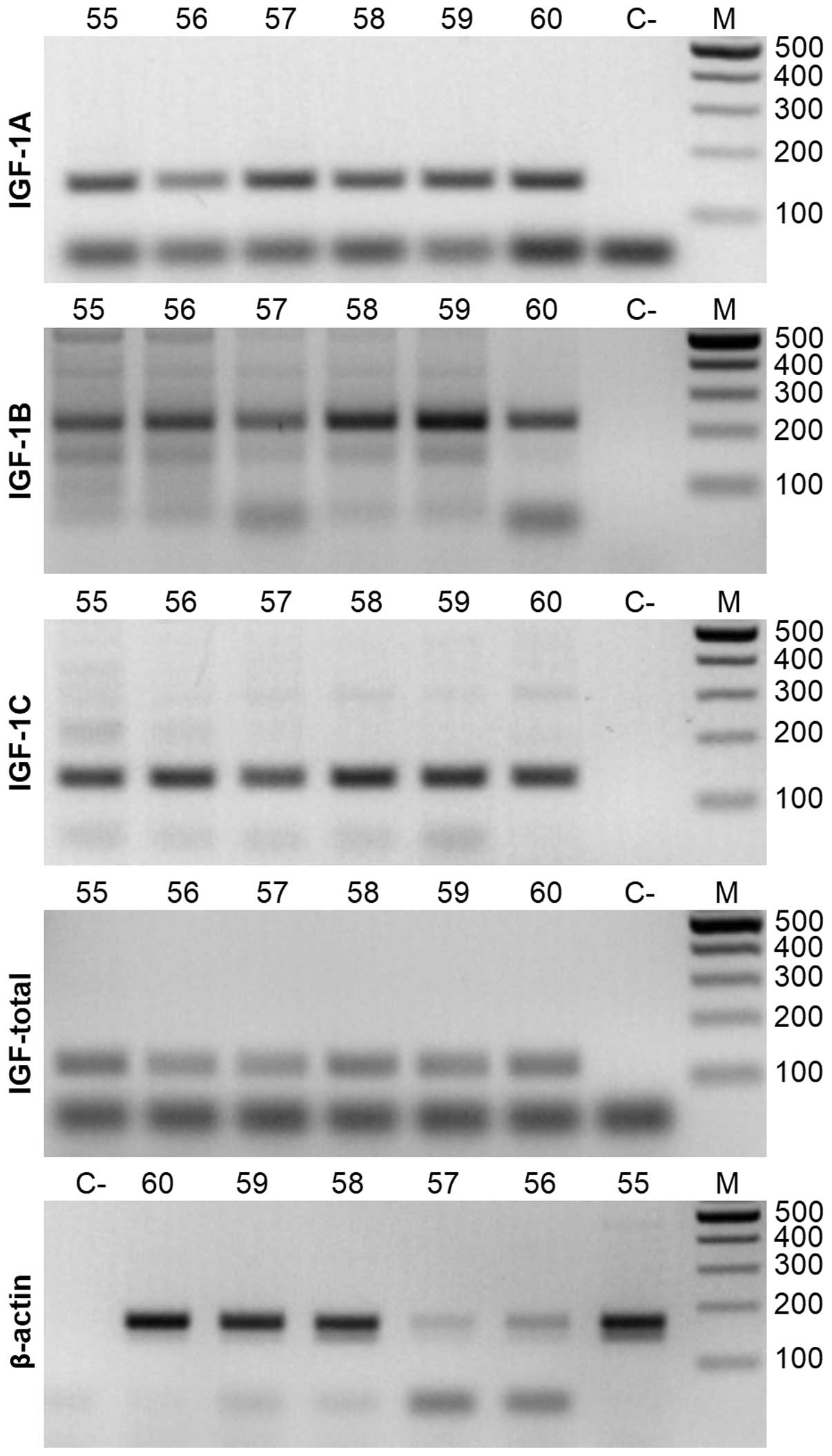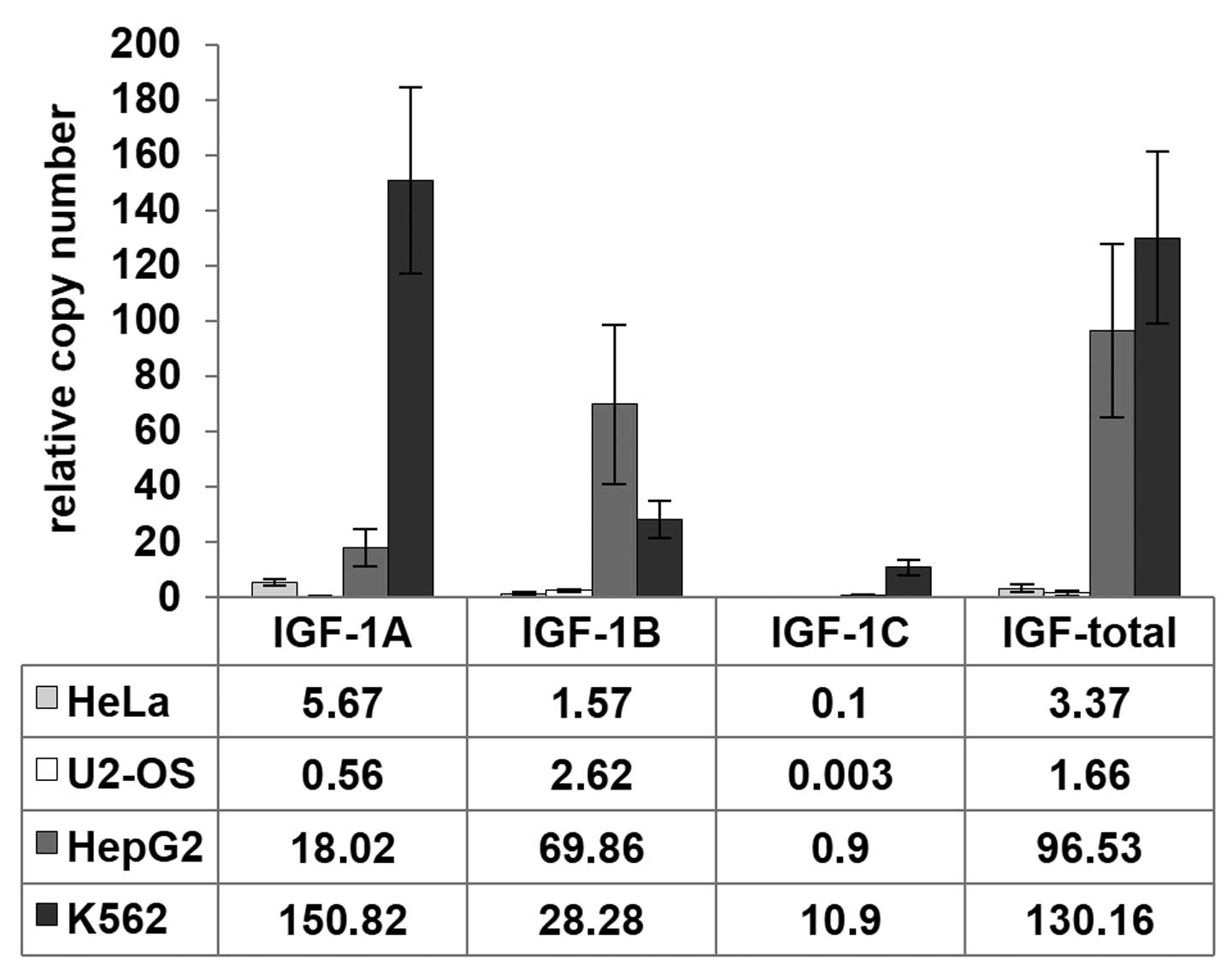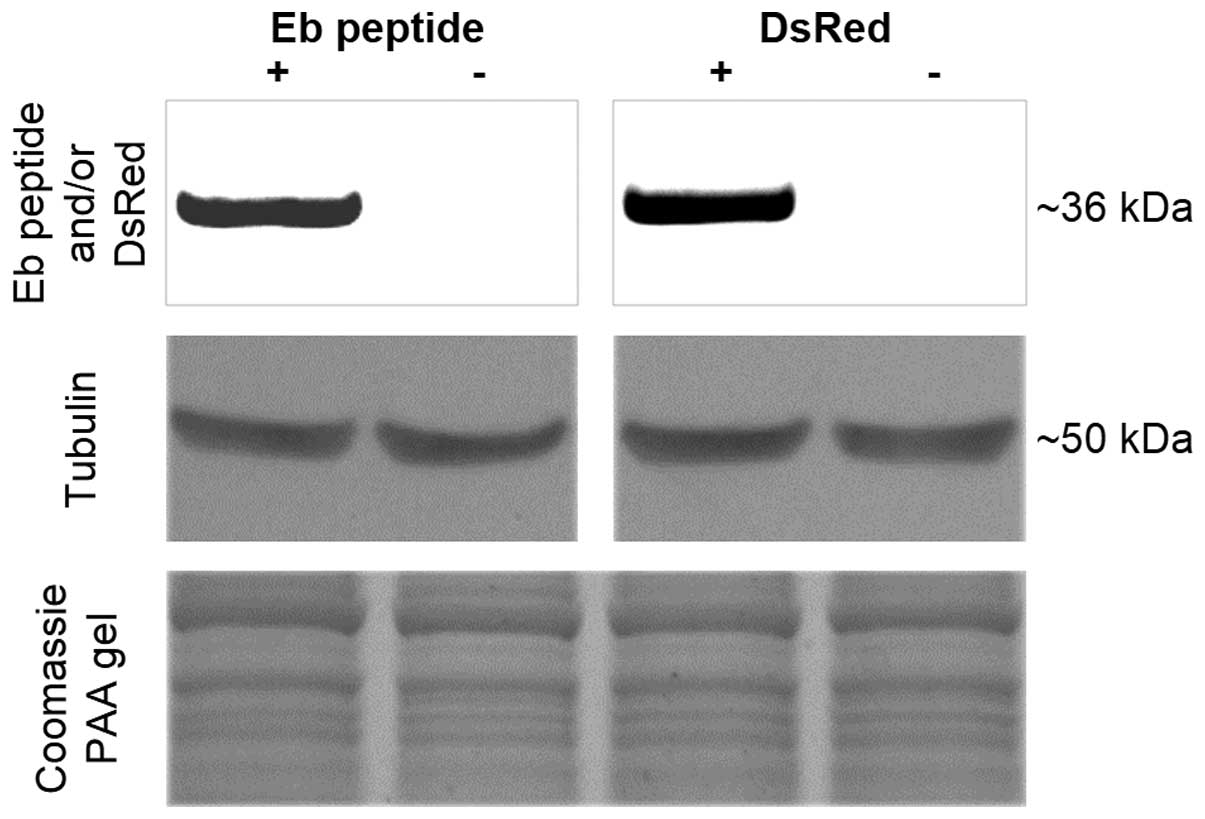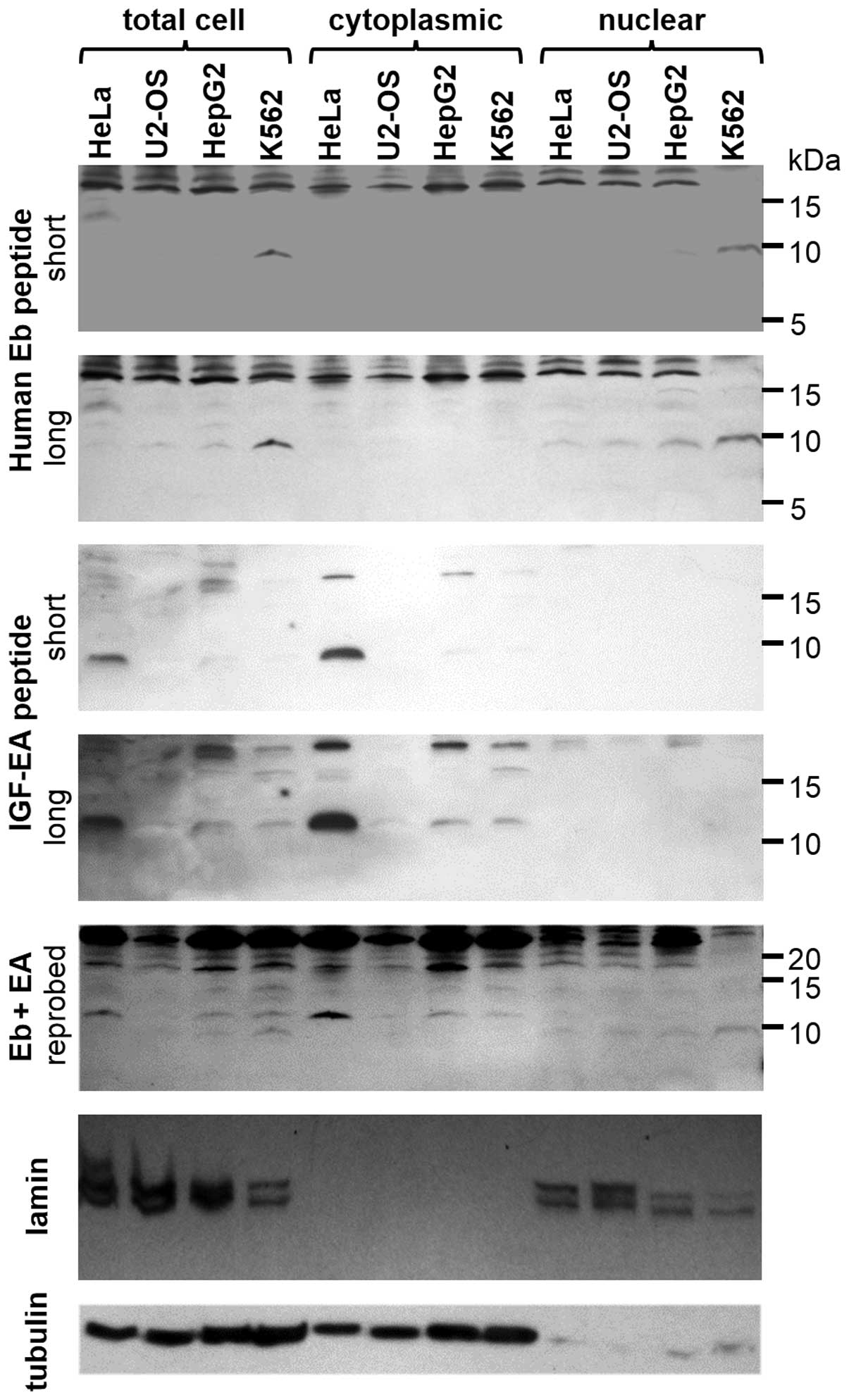|
1
|
Brett D, Pospisil H, Valcárcel J, Reich J
and Bork P: Alternative splicing and genome complexity. Nat Genet.
30:29–30. 2002. View
Article : Google Scholar : PubMed/NCBI
|
|
2
|
Roy B, Haupt LM and Griffiths LR: Review:
alternative splicing (AS) of genes as an approach for generating
protein complexity. Curr Genomics. 14:182–194. 2013. View Article : Google Scholar : PubMed/NCBI
|
|
3
|
Renaville R, Hammadi M and Portetelle D:
Role of the somatotropic axis in the mammalian metabolism. Domest
Anim Endocrinol. 23:351–360. 2002. View Article : Google Scholar : PubMed/NCBI
|
|
4
|
Langdahl BL, Kassem M, Møller MK and
Eriksen EF: The effects of IGF-I and IGF-II on proliferation and
differentiation of human osteoblasts and interactions with growth
hormone. Eur J Clin Invest. 28:176–183. 1998. View Article : Google Scholar : PubMed/NCBI
|
|
5
|
Siegfried JM, Kasprzyk PG, Treston AM,
Mulshine JL, Quinn KA and Cuttitta F: A mitogenic peptide amide
encoded within the E peptide domain of the insulin-like growth
factor IB prohormone. Proc Natl Acad Sci USA. 89:8107–8111. 1992.
View Article : Google Scholar : PubMed/NCBI
|
|
6
|
Kuo YH and Chen TT: Novel activities of
pro-IGF-I E peptides: regulation of morphological differentiation
and anchorage-independent growth in human neuroblastoma cells. Exp
Cell Res. 280:75–89. 2002. View Article : Google Scholar
|
|
7
|
Matheny RW Jr and Nindl BC: Loss of
IGF-IEa or IGF-IEb impairs myogenic differentiation. Endocrinology.
152:1923–1934. 2011. View Article : Google Scholar : PubMed/NCBI
|
|
8
|
Hede MS, Salimova E, Piszczek A, et al:
E-peptides control bioavailability of IGF-1. PLoS One.
7:e511522012. View Article : Google Scholar : PubMed/NCBI
|
|
9
|
Barton ER: The ABCs of IGF-I isoforms:
impact on muscle hypertrophy and implications for repair. Appl
Physiol Nutr Metab. 31:791–797. 2006. View
Article : Google Scholar : PubMed/NCBI
|
|
10
|
Tian XC, Chen MJ, Pantschenko AG, Yang TJ
and Chen TT: Recombinant E-peptides of pro-IGF-I have mitogenic
activity. Endocrinology. 140:3387–3390. 1999. View Article : Google Scholar : PubMed/NCBI
|
|
11
|
Brisson BK and Barton ER: New modulators
for IGF-I activity within IGF-I processing products. Front
Endocrinol (Lausanne). 4:422013.PubMed/NCBI
|
|
12
|
Durzyńska J, Philippou A, Brisson BK,
Nguyen-McCarty M and Barton ER: The pro-forms of insulin-like
growth factor I (IGF-I) are predominant in skeletal muscle and
alter IGF-I receptor activation. Endocrinology. 154:1215–1224.
2013.PubMed/NCBI
|
|
13
|
Tan DS, Cook A and Chew SL: Nucleolar
localization of an isoform of the IGF-I precursor. BMC Cell Biol.
3:172002. View Article : Google Scholar : PubMed/NCBI
|
|
14
|
Durzyńska J, Wardziński A, Koczorowska M,
Goździcka-Józefiak A and Barton ER: Human Eb peptide: not just a
by-product of pre-pro-IGF1b processing? Horm Metab Res. 45:415–422.
2013.PubMed/NCBI
|
|
15
|
Brisson BK and Barton ER: Insulin-like
growth factor-I E-peptide activity is dependent on the IGF-I
receptor. PLoS One. 7:e455882012. View Article : Google Scholar : PubMed/NCBI
|
|
16
|
Aro AL, Savikko J, Pulkkinen V and von
Willebrand E: Expression of insulin-like growth factors IGF-I and
IGF-II, and their receptors during the growth and megakaryocytic
differentiation of K562 cells. Leuk Res. 26:831–837. 2002.
View Article : Google Scholar : PubMed/NCBI
|
|
17
|
Wahner Hendrickson AE, Haluska P,
Schneider PA, et al: Expression of insulin receptor isoform A and
insulin-like growth factor-1 receptor in human acute myelogenous
leukemia: effect of the dual-receptor inhibitor BMS-536924 in
vitro. Cancer Res. 69:7635–7643. 2009.PubMed/NCBI
|
|
18
|
Philippou A, Stavropoulou A, Sourla A, et
al: Characterization of a rabbit antihuman mechano growth factor
(MGF) polyclonal antibody against the last 24 amino acids of the E
domain. In Vivo; 22:27–35. 2008.PubMed/NCBI
|
|
19
|
Harris JR and Markl J: Keyhole limpet
hemocyanin (KLH): a biomedical review. Micron. 30:597–623. 1999.
View Article : Google Scholar : PubMed/NCBI
|
|
20
|
Lowe WL Jr, Lasky SR, LeRoith D and
Roberts CT Jr: Distribution and regulation of rat insulin-like
growth factor I messenger ribonucleic acids encoding alternative
carboxyterminal E-peptides: evidence for differential processing
and regulation in liver. Mol Endocrinol. 2:528–535. 1988.
View Article : Google Scholar
|
|
21
|
Wallis M: New insulin-like growth factor
(IGF)-precursor sequences from mammalian genomes: the molecular
evolution of IGFs and associated peptides in primates. Growth Horm
IGF Res. 19:12–23. 2009. View Article : Google Scholar : PubMed/NCBI
|
|
22
|
Pfeffer LA, Brisson BK, Lei H and Barton
ER: The insulin-like growth factor (IGF)-I E-peptides modulate cell
entry of the mature IGF-I protein. Mol Biol Cell. 20:3810–3817.
2009. View Article : Google Scholar : PubMed/NCBI
|
|
23
|
Adamo ML, Neuenschwander S, LeRoith D and
Roberts CT Jr: Structure, expression, and regulation of the IGF-I
gene. Adv Exp Med Biol. 343:1–11. 1993. View Article : Google Scholar : PubMed/NCBI
|
|
24
|
Kasprzak A, Szaflarski W, Szmeja J, et al:
Differential expression of IGF-1 mRNA isoforms in colorectal
carcinoma and normal colon tissue. Int J Oncol. 42:305–316.
2013.PubMed/NCBI
|
|
25
|
Kasprzak A, Szaflarski W, Szmeja J, et al:
Expression of various insulin-like growth factor-1 mRNA isoforms in
colorectal cancer. Contemp Oncol (Pozn). 16:147–153.
2012.PubMed/NCBI
|
|
26
|
Koczorowska MM, Kwasniewska A and
Gozdzicka-Jozefiak A: IGF1 mRNA isoform expression in the cervix of
HPV-positive women with pre-cancerous and cancer lesions. Exp Ther
Med. 2:149–156. 2011.PubMed/NCBI
|
|
27
|
Cui H, Yi Q, Feng J, Yang L and Tang L:
Mechano growth factor E peptide regulates migration and
differentiation of bone marrow mesenchymal stem cells. J Mol
Endocrinol. 52:111–120. 2014. View Article : Google Scholar : PubMed/NCBI
|
|
28
|
Wu J, Wu K, Lin F, et al: Mechano-growth
factor induces migration of rat mesenchymal stem cells by altering
its mechanical properties and activating ERK pathway. Biochem
Biophys Res Commun. 441:202–207. 2013. View Article : Google Scholar : PubMed/NCBI
|
|
29
|
Fornaro M, Hinken AC, Needle S, et al:
Mechano-growth factor peptide, the COOH terminus of unprocessed
insulin-like growth factor 1, has no apparent effect on myoblasts
or primary muscle stem cells. Am J Physiol Endocrinol Metab.
306:E150–E156. 2014. View Article : Google Scholar : PubMed/NCBI
|
|
30
|
Armakolas A, Philippou A, Panteleakou Z,
et al: Preferential expression of IGF-1Ec (MGF) transcript in
cancerous tissues of human prostate: evidence for a novel and
autonomous growth factor activity of MGF E peptide in human
prostate cancer cells. Prostate. 70:1233–1242. 2010. View Article : Google Scholar
|
|
31
|
Philippou A, Armakolas A and Koutsilieris
M: Evidence for the possible biological significance of the IGF-1
gene alternative splicing in prostate cancer. Front Endocrinol
(Lausanne). 4:312013.PubMed/NCBI
|
|
32
|
Straub L: Beyond the transcripts: what
controls protein variation? PLoS Biol. 9:e10011462011. View Article : Google Scholar : PubMed/NCBI
|
|
33
|
Vogel C and Marcotte EM: Insights into the
regulation of protein abundance from proteomic and transcriptomic
analyses. Nat Rev Genet. 13:227–232. 2012.PubMed/NCBI
|
|
34
|
Klevebring D, Fagerberg L, Lundberg E,
Emanuelsson O, Uhlén M and Lundeberg J: Analysis of transcript and
protein overlap in a human osteosarcoma cell line. BMC Genomics.
11:6842010. View Article : Google Scholar : PubMed/NCBI
|
|
35
|
Dengler MA, Weilbacher A, Gutekunst M, et
al: Discrepant NOXA (PMAIP1) transcript and NOXA protein levels: a
potential Achilles’ heel in mantle cell lymphoma. Cell Death Dis.
5:e10132014.PubMed/NCBI
|
|
36
|
Mole S, McFarlane M, Chuen-Im T, Milligan
SG, Millan D and Graham SV: RNA splicing factors regulated by HPV16
during cervical tumour progression. J Pathol. 219:383–391. 2009.
View Article : Google Scholar : PubMed/NCBI
|
|
37
|
Condemine W, Takahashi Y, Zhu J, et al:
Characterization of endogenous human promyelocytic leukemia
isoforms. Cancer Res. 66:6192–6198. 2006. View Article : Google Scholar : PubMed/NCBI
|
|
38
|
Nojima T, Oshiro-Ideue T, Nakanoya H, et
al: Herpesvirus protein ICP27 switches PML isoform by altering mRNA
splicing. Nucleic Acids Res. 37:6515–6527. 2009. View Article : Google Scholar : PubMed/NCBI
|
|
39
|
Liu Y, Tong Z, Li T, et al: Hepatitis B
virus × protein stabilizes amplified in breast cancer 1 protein and
cooperates with it to promote human hepatocellular carcinoma cell
invasiveness. Hepatology. 56:1015–1024. 2012.
|
|
40
|
Kalamvoki M and Roizman B: HSV-1 degrades,
stabilizes, requires, or is stung by STING depending on ICP0, the
US3 protein kinase, and cell derivation. Proc Natl Acad Sci USA.
111:E611–E617. 2014. View Article : Google Scholar : PubMed/NCBI
|


















